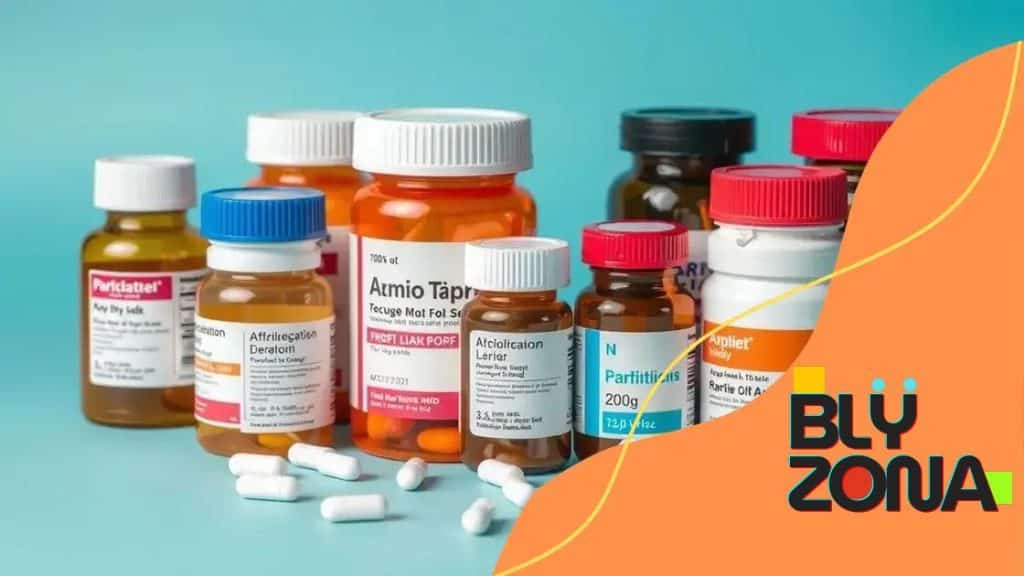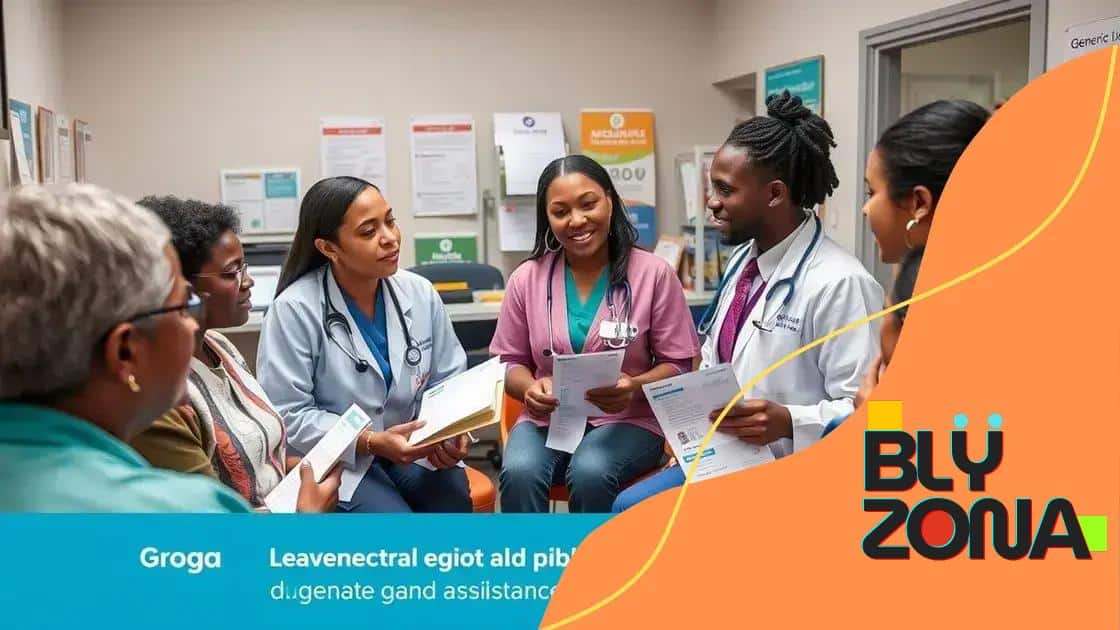Expanded access to affordable prescription drugs benefits everyone

Expanded access to affordable prescription drugs enhances public health by improving medication availability, reducing costs through various programs, and empowering patients to take control of their healthcare.
Expanded access to affordable prescription drugs is a pressing issue that affects countless lives. Have you or someone you know struggled with high medication costs? This article will discuss the importance of making prescriptions more accessible and affordable for everyone.
Understanding affordable prescription drugs
Understanding affordable prescription drugs is key to better health. Many people struggle to access the medications they need due to high costs. When we talk about affordability, we’re not just discussing price tags; it’s about ensuring everyone can obtain necessary treatments without financial stress.
What Makes Prescription Drugs Expensive?
Several factors contribute to the high cost of medications. The most significant include research and development costs, marketing expenses, and the lack of competition in some drug markets. Each new drug undergoes stringent testing and approval processes, which can drive up prices significantly.
- High R&D costs burden companies.
- Marketing adds to overall drug expenses.
- Limited competition keeps prices elevated.
- Patents restrict generic options.
Despite these challenges, there are paths to make drugs affordable. Programs designed to extend access to affordable prescription drugs can lower costs. For example, government initiatives can help regulate prices and facilitate competition among pharmaceutical companies.
Programs Enhancing Access
Several programs aim to improve access to medications. These initiatives can provide financial assistance, discounts, or free medications to eligible individuals. Understanding how these programs work can empower patients.
- Patient assistance programs by manufacturers.
- State and federal discount programs.
- Nonprofit organizations offering aid.
Also, utilizing generic medications is a practical way to save money. Generic drugs are often significantly less expensive than their brand-name counterparts while offering the same therapeutic benefits. Awareness of these alternatives can help individuals reduce their medication costs.
The Role of Insurance
Health insurance also plays a vital role in determining the affordability of prescriptions. Many plans cover a part of the medication costs, but coverage varies greatly. Understanding your insurance plan can prevent surprises at the pharmacy. Checking your formulary list helps you know which drugs are covered and at what price.
In summary, understanding affordable prescription drugs involves recognizing the factors contributing to costs, available programs to reduce them, the importance of generics, and the impact of health insurance. By being informed, patients can take proactive steps in managing their healthcare expenses.
The impact of expanded access on public health
The impact of expanded access to affordable prescription drugs on public health is profound. When people can obtain essential medications, it leads to better health outcomes. For instance, patients are more likely to adhere to treatment regimens when they are not financially burdened.
Improved Health Outcomes
Access to affordable medications reduces the incidence of disease progression. When patients can afford their prescriptions, they experience fewer complications, leading to lower rates of hospitalization. As a result, communities see significant benefits, including:
- Lower healthcare costs overall.
- Increased life expectancy.
- Reduced emergency room visits.
- Improved quality of life.
Moreover, expanded access encourages early intervention for chronic conditions, such as diabetes and hypertension. Early treatment can prevent more serious complications and improve long-term health.
Economic Benefits
Not only does access to medications affect individual health, but it also impacts the economy. When the population is healthier, productivity increases. Workers are less likely to miss work due to illness, which benefits businesses and the economy as a whole.
Additionally, governments spend less on healthcare when people manage their health effectively. Programs dedicated to enhancing drug access enhance public health on multiple levels.
Community Well-Being
Furthermore, improved access fosters a sense of community well-being. Individuals feel more empowered when they can manage their health, leading to increased community engagement. This empowerment can drive changes in health policies and promote advocacy for affordable prescription drugs.
In summary, the impact of expanded access on public health encompasses healthier individuals, economic advantages, and stronger communities. This comprehensive approach is essential for creating a healthier society.
Strategies for improving drug affordability

Strategies for improving drug affordability are essential in today’s healthcare landscape. Many people struggle to pay for their medications, which can lead to serious health consequences. Finding ways to lower these costs is crucial for individuals and communities alike.
Utilizing Generic Medications
One effective strategy is to promote the use of generic medications. Generics often cost significantly less than brand-name drugs while providing the same therapeutic benefits. Patients can save money by asking their healthcare providers about generic alternatives when prescribed medications.
- Generics provide equal effectiveness.
- Lower prices increase medication adherence.
- More availability in pharmacies.
Additionally, many insurance plans cover generics at lower copayment rates, making them even more accessible for patients.
Patient Assistance Programs
Another way to enhance affordability is through patient assistance programs offered by pharmaceutical companies. These programs help individuals who qualify to receive medications at reduced costs or even for free. Patients should research and inquire about available programs for the drugs they need.
- Eligibility varies based on income.
- Programs often include enrollment forms.
- Support from healthcare providers can help navigate options.
Awareness of these programs can empower patients to seek the assistance they require. Sometimes, simply informing people about these resources can lead to significant savings.
Advocating for Policy Changes
Advocacy plays a critical role in improving drug affordability. Individuals can participate in campaigns that push for legislative changes to control drug prices. Engaging with local representatives can influence public policy and lead to more equitable healthcare solutions.
Communities can work together to advocate for:
- Price negotiation policies for public health programs.
- Legislation supporting transparency in pricing.
- Increased funding for health programs.
Implementing these strategies can effectively address the rising costs of medications. Fear of high prices should not hinder individuals from seeking the healthcare they need. By improving drug affordability, we can enhance public health and well-being.
Legal frameworks supporting access to medication
Legal frameworks supporting access to medication are crucial for ensuring that everyone can obtain necessary treatments. These laws and regulations help to lower costs, enhance the availability of drugs, and protect patients’ rights. Understanding these frameworks is essential when discussing expanded access to affordable prescription drugs.
Key Legislation
Several key pieces of legislation have been enacted to support medication access. These laws exist at both the federal and state levels, providing a foundation for improving healthcare.
- The Affordable Care Act (ACA) helps to expand insurance coverage.
- The Drug Price Competition and Patent Term Restoration Act encourages generic drug use.
- The 340B Drug Pricing Program requires manufacturers to provide discounts to eligible healthcare entities.
These laws aim to make medications more affordable and accessible, recognizing the critical role they play in public health.
Intellectual Property Rights
Intellectual property laws impact access to medication significantly. While they protect innovation, they can also hinder the availability of affordable drugs. Balancing these interests is essential. By allowing for generic versions of medications upon patent expiration, we can improve affordability.
International agreements like the TRIPS Agreement also influence how countries manage drug patents and accessibility. Countries can implement legal exceptions that facilitate greater access to life-saving medications.
State-Level Initiatives
In addition to federal laws, various states have introduced their own initiatives to support medication access. These can include:
- Public programs offering low-cost drugs to residents.
- Reforms that require transparency in drug pricing.
- Collaboration with pharmaceutical companies to create discount programs.
States vary in their approaches, but many are working toward similar goals: enhancing accessibility and reducing costs.
Patient Rights and Access
Legal frameworks also protect patients’ rights to access medications. These rights ensure that individuals are not discriminated against based on their economic status. Laws such as the Americans with Disabilities Act (ADA) also play a part in ensuring that individuals with health conditions can access necessary medications without barriers.
Supporting access to medications through robust legal frameworks is a fundamental aspect of public health policy. By understanding these laws, patients can better navigate their options for accessing needed medications.
Future trends in prescription drug accessibility
Future trends in prescription drug accessibility are emerging as technology and policy evolve. As we move forward, several key changes are shaping how people obtain their medications. Understanding these trends is vital for patients and healthcare providers alike.
Increased Use of Telemedicine
Telemedicine is gaining popularity, allowing patients to consult with healthcare providers remotely. This approach can improve access to prescriptions, especially for those in rural or underserved areas. Patients can receive consultations from the comfort of their homes, making it easier to obtain necessary medications.
- Eliminates travel barriers for patients.
- Offers convenience and flexibility for consultations.
- Facilitates quicker access to prescriptions.
As telemedicine continues to expand, it could lead to higher rates of medication adherence among patients.
Advancements in Medication Delivery
Another trend is the advancement of medication delivery systems. Companies are developing innovative ways to deliver prescriptions directly to patients’ doorsteps. This can make accessing necessary medications faster and more convenient. Home delivery services are becoming more common, allowing patients to receive medications without the need to visit a pharmacy.
- Reduces waiting times at pharmacies.
- Provides discreet delivery for sensitive medications.
- Improves adherence through convenient options.
These advancements not only enhance convenience but also improve overall patient experiences.
Focus on Patient-Centered Policies
Additionally, we are likely to see a stronger focus on patient-centered policies. Governments and organizations are recognizing the importance of putting patients first. This can lead to reforms aimed at improving affordability and access to medications. For example, initiatives that prioritize affordable prescription drugs can empower patients in their healthcare journey.
Policies may include:
- Price negotiation for medications.
- Increased transparency in drug pricing.
- Support for community health programs.
As these policies develop, they may expand access for millions of individuals.
Integration of Technology
Finally, technology will play a critical role in shaping the future of accessibility. With the rise of mobile health apps, patients can more easily manage their medication schedules and receive reminders. Additionally, artificial intelligence (AI) may help healthcare providers make better prescribing decisions by analyzing patient data more efficiently.
Ultimately, the future of prescription drug accessibility looks promising. By embracing these trends, we can work toward a healthcare system that ensures everyone has access to the medications they need.
FAQ – Frequently Asked Questions about Access to Affordable Prescription Drugs
What is meant by ‘expanded access’ to prescription drugs?
Expanded access refers to efforts and programs aimed at making medications more affordable and accessible to everyone.
How does telemedicine improve prescription access?
Telemedicine allows patients to consult with healthcare providers remotely, making it easier for them to get the prescriptions they need without traveling.
What types of programs can help reduce the costs of medications?
Patient assistance programs offered by pharmaceutical companies, as well as state and federal discount programs, can help lower medication costs for eligible patients.
Why is advocacy important in the context of medication access?
Advocacy helps push for legislative changes that can lower drug prices and improve overall access to necessary medications for the public.





